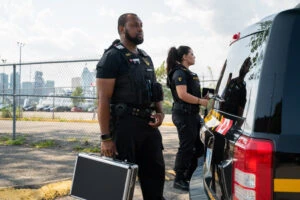In an increasingly unpredictable world, the importance of robust event security for high-profile clients cannot be understated. When the stakes are high, a nuanced understanding of event security best practices becomes indispensable.
High-profile events, be it corporate conclaves or star-studded galas, demand a security protocol that is foolproof, discreet, and uncompromising. This encompasses not just physical security but also incorporates risk management, crisis response, and digital security measures.
Understanding this intricate tapestry of security demands is key to ensuring the safety and success of any event catering to high-profile clientele. It’s not just about ticking boxes on a checklist, it’s about creating an environment where attendees can focus on their objectives, free from worry about potential threats or disruptions.
Risk Assessment and Security Planning: Laying the Groundwork for a Secure Event

A comprehensive risk assessment is the cornerstone of effective event security planning. By examining all aspects of your event—from the venue and expected attendance to potential threats and vulnerabilities—experienced security professionals can develop a tailored security plan that addresses your unique concerns.
Key steps in conducting risk assessments and security planning include:
1. Venue Analysis: Assess the security of the event venue and its surroundings, identifying potential risks and vulnerabilities related to access control, crowd management, and emergency response capabilities.
2. Threat Assessment: Consider potential threats specific to your event, such as protests, targeted attacks, or natural disasters, and prioritise measures to address these risks.
3. Security Resource Allocation: Strategically allocate security resources, including personnel and equipment, to ensure comprehensive coverage and effective risk mitigation.
Crowd Control Measures: Managing Attendees and Ensuring Smooth Operations
Effective crowd control is essential for maintaining a safe and enjoyable atmosphere at your event. Implementing measures that facilitate smooth operations while preventing overcrowding and disorder helps ensure the safety of your guests and staff.
Consider the following crowd control strategies:
1. Access and Entry Point Management: Establish clear entry and exit points for your event, utilising barriers and signage to guide attendees and maintain order.
2. Queue Management: Implement organised queuing systems for admission and services, such as food and beverage stations or restrooms, to prevent congestion and maintain social distancing where necessary.
3. Security Personnel Deployment: Assign experienced security personnel to monitor and manage crowds, addressing potential issues and responding rapidly to any emerging concerns.
Emergency Preparedness: Anticipating and Responding to Unforeseen Situations

No event can be completely immune to unexpected incidents or emergencies. Developing a robust emergency preparedness plan is crucial in ensuring the safety of your guests, staff, and property in the event of a crisis.
Key elements of emergency preparedness include:
1. Emergency Response Plan: Develop and implement a comprehensive emergency response plan, outlining the roles and responsibilities of staff and security personnel in handling various scenarios, such as medical emergencies, evacuations, or security breaches.
2. Communication Protocols: Establish clear communication protocols and channels, ensuring security personnel, staff, and emergency services can communicate efficiently and effectively during an incident.
3. First Aid and Medical Support: Provide on-site first aid and medical support, including trained personnel and necessary equipment, to address injuries or health concerns promptly.
Coordination with Local Authorities: Ensuring Compliance and Collaboration
Working closely with local authorities is essential for maintaining a safe and secure event environment. Coordination with law enforcement, emergency services, and regulatory agencies helps ensure compliance with local regulations and facilitates a rapid response to any emerging concerns.
Strategies for effective coordination with local authorities include:
1. Permit and Regulation Compliance: Obtain all necessary permits for your event and ensure compliance with local regulations regarding security measures, capacity limits, and other pertinent aspects.
2. Liaison with Law Enforcement: Establish a direct line of communication between your event security team and local law enforcement, enabling seamless coordination in the event of a security concern or incident.
3. Collaboration with Emergency Services: Coordinate with local emergency services, such as fire and rescue departments and medical services, to ensure rapid response capabilities and familiarity with your event’s emergency procedures.
Partner with Ultimate Security Services for Exceptional Event Security Solutions
In essence, the success of an event involving high-profile clients is directly proportional to the level of security preparedness and implementation. It requires a strategic combination of standardised and customised security measures, collaboration with law enforcement, and continuous training and evaluation of the security team.
Ultimate Security Services is committed to providing unparalleled event security solutions tailored to the unique needs of high-profile clients. Our team of seasoned security professionals is dedicated to safeguarding your event and ensuring the safety and enjoyment of your guests.
Contact us today to learn more about our security guard services in Toronto. Together, we can create a secure and successful event experience that leaves a lasting impression on your guests while upholding the exceptional standards of safety you demand as a high-profile client.




